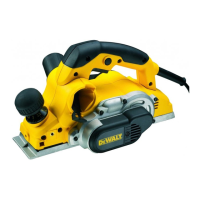23
ENGLISH
2. To remove the ejector, raise the lever
19
and pull out
theejector.
NOTE: The ejector must be used in combination with the dust
extraction adapter when connecting a vacuumextractor
For left-hand side shavings discharge (Fig.F), the ejector
must always beused.
1. Raise the lever
19
to open the spring-loaded closure
20
.
2. Push the ejector
18
into the left-hand side shavings
discharge outlet
3
until it clicks inplace.
3. Release thelever.
4. To remove the ejector, raise the lever and pull out
theejector.
Dust Extraction (Fig. G–I)
WARNING: When appropriate, connect a dust extraction
system designed in compliance with the applicable
directives regarding dustemission.
The tool is supplied with an adapter for connecting a dustbag or
a vacuum extractor. The dustbag is standard for K-models and
available as an option for all othermodels.
1. Fit the shavings ejector
18
into the outlet
3
asshown.
2. Attach the dustbag
21
to the shavingsejector.
3. Alternatively, connect the tool to a vacuum extractor using
the adapter
22
.
Assembling the Dustbag (Fig.I)
1. Assemble the dustbag by aligning the open ended slots
26
with the notches
25
and fitting the
23
deflector onto the
bag
24
.
2. Turn the assembly clockwise to lock it inposition.
3. Release the loops
52
to unfold thebag.
4. Fit the dustbag as describedabove.
Prior to Operation
• Adjust the depth ofcut.
• If necessary, fit and adjust the parallelfence.
• If necessary, fit and adjust the rebating depth stop.
• Attach the shavingsejector.
• If necessary, connect the dust extraction.
• Use sharp cutting bladesonly.
OPERATION
Instructions for Use
WARNING: Always observe the safety instructions and
applicableregulations.
WARNING: To reduce the risk of serious personal
injury, turn tool off and disconnect tool from power
source before making any adjustments or removing/
installing attachments or accessories. Be sure the
trigger switch is in the OFF position. An accidental start-up
can cause injury.
Proper Hand Position (Fig. J)
WARNING: To reduce the risk of serious personal injury,
ALWAYS use proper hand position asshown.
WARNING: To reduce the risk of serious personal
injury, ALWAYS hold securely in anticipation of a
suddenreaction.
Proper hand position requires one hand on the front handle
4
,
with the other hand on the main handle
20
.
Switching On and Off (Fig. A)
WARNING: Do not switch the tool on or off when the
cutters touch the workpiece or othermaterials.
For safety reasons the on/off switch
1
of your tool is equipped
with a lock-off button
2
.
1. Press the lock-off button to unlock thetool.
2. To run the tool, press the on/off switch
1
. As soon as the
on/off switch is released the lock-off switch is automatically
activated to prevent unintended starting of themachine.
Planing (Fig. A)
1. Switch the toolon.
2. Slowly move the tool over theworkpiece.
WARNING:
• The feed speed should not be too high, especially
when using the maximum depth of cut and
planingwidth.
• Remember that several shallow cuts are better than
one deepcut.
• Always switch off the tool when work is finished and
beforeunplugging.
The tool is equipped with a parking shoe
6
. After switching
off, the tool can be put down without waiting for the cutters to
come to astandstill.
Rebating
1. Fit and adjust the parallelfence.
2. Fit and adjust the rebating depthstop.
3. Proceed as forplaning.
Chamfering Edges
The V-grooves in the nose piece of the shoe enable you to
chamferedges.
Emptying the Dustbag (Fig. G–I)
The amount of shavings collected in the dustbag can be
determined from the transparentdeflector.
1. Remove the dustbag
21
.
2. Remove the deflector
23
from the bag
24
by turning it
counterclockwise.
3. Empty the contents of the bag into a wastecontainer.
4. Re-assemble the dustbag by aligning the open ended
slots
26
with the notches
25
and fitting the deflector onto
thebag.
5. Turn the assembly clockwise to lock it inposition.
6. Re-fitdustbag.

